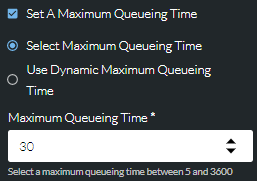SIP Trunk
|
Routes a call to an IP-PBX or SIP gateway device over a SIP trunk configured by your supplier. |

Depending on your implementation, a SIP trunk could refer to a connection to a particular site, a specific PBX, or a data centre.
Properties
SIP Trunk Properties Section
|
Option |
Description |
|
SIP Trunk |
Select the configured SIP trunk over which to route calls. |
|
Onward Route Number |
Enter the destination routing number as a literal value or a user string variable. This can be the full DDI of the destination, or any number (such as local extension number) that is recognised as a routing code at the PBX where the SIP trunk terminates. |
|
Select Call Timeout Period/ Use Dynamic Call Timeout Period Timeout |
The number of seconds for which to try calling on the SIP trunk. Use the Select Call Timeout Period option to enter a value between 5 and 180s, or use the Use Dynamic Call Timeout Period to use a user integer or float variable containing the timeout value (float values are rounded down to the nearest integer at run time). |
|
Record Call |
Select this to activate call recording on the SIP trunk. |
SIP Media Properties Section
|
Option |
Description |
|
Select Media List/ Use Dynamic Media Lists/ Media Lists/ Whisper Prompt/ Play Whisper Prompt To |
Use this to play an audio whisper prompt (such as a beep or a statement) to the called party or to both parties immediately before the call connects. Where multiple access numbers invoke the same script, whisper prompts can be used to inform the called party of the call origin, based on the access number dialled by the caller or their CLI (identified using the Group Routing or Select Case action cell). If you do not want a whisper prompt to be played, leave the Whisper Prompt check box clear. See also, Use Media in a Script. |
Queueing Properties Section
|
Option |
Description |
|
Enable Call Queueing |
Select this to place callers on hold for an unlimited or selected period while the line is busy. |
|
Set a Maximum Queueing Time |
Select Set a Maximum Queueing Time if you want to set a period for which a queued all should wait before the next number in the list is tried or (for the last or only number) execution should follow the cell's Failure exit point. This timeout overrides the call timeout period. Then, either use the first option to select a maximum queueing time from the options list:
Or, use the second option to provide the time using a variable:
|
Exit Points
|
Exit Point |
Description |
|
Success |
This is taken when the call ends. |
|
Failure |
This is taken when all attempts to route the call have failed. |
|
Error |
This is taken when the whisper prompt file specified in the properties cannot be located. |

